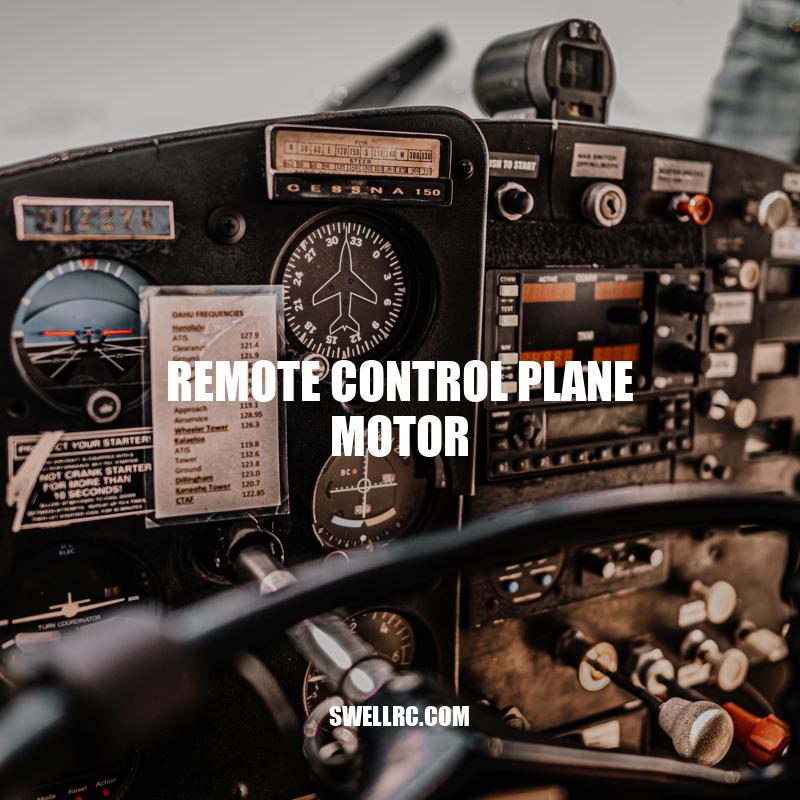Remote Control Plane Motors: Types, Mechanism, and Maintenance
Remote control planes have been a popular hobby and sport for many years. The ability to fly an aircraft from the ground brings immense pleasure to aviation enthusiasts. Remote control planes are available in different sizes and shapes, and they are powered by various types of motors. The remote control plane motor is an essential part of a remote control plane, providing it with necessary power and thrust. With advances in technology, remote control plane motors have become more efficient and powerful, providing better flying experiences. In this article, we will discuss the different types and workings of remote control plane motors, emphasizing their maintenance and upkeep. Regardless of the type of motor used, it is essential to understand how they function and how to maintain them properly. Investing in the right motor and maintaining it well, will enhance the lifespan of your remote control plane, and ensure optimal performance. As a result, the pilot can enjoy flying the aircraft for years to come.
Remote control plane motors come in three types: electric, glow, and gas engines. Each has its own strengths and weaknesses. The type of motor used depends on the size and weight of the plane and the personal preferences of the pilot. Here is a breakdown of each type:
- Electric: These are the most common motors used in remote control planes. They are easy to use, cost-effective, and require less fuel. They are powered by a battery and are ideal for smaller planes. Electric motors come in two varieties: brushed and brushless. Brushed motors are cheaper and easier to maintain, but less powerful. Brushless motors are more expensive and require less maintenance, but more powerful.
- Glow: Glow engines run on a fuel mixture made from methanol, castor oil, and nitromethane. They are more expensive and require more maintenance than electric motors but have a better power-to-weight ratio. Glow engines are ideal for smaller planes and are popular with model airplane enthusiasts.
- Gas: Gas engines are much larger and heavier than electric or glow engines. They are powered by gasoline or petrol fuel and are typically used for larger planes. They are expensive, require more maintenance, but have a better power-to-weight ratio than other types of motors. Gas engines are popular with aviation enthusiasts who want to fly larger, more complex planes.
When choosing a motor, it’s important to consider the size and weight of your plane, as well as your own personal preferences. There are many websites and resources available to help you choose the right motor for your needs. Some popular websites for remote control plane hobbyists include Tower Hobbies, Horizon Hobby, and RC Universe.
What are the different types of motor used in aircraft?
There are several types of motors used in aircraft. These include:
- Turboprop engines
- Turbofan engines
- Turbojet engines
- Rocket engines
- Piston engines
Turboprop engines are commonly used in smaller aircrafts and provide a balance of performance and fuel efficiency. Turbofan engines are one of the most common types of engines used in commercial aircrafts due to their fuel efficiency and lower noise levels. Turbojet engines are used in military aircrafts and high-speed commercial planes because of their high thrust and speed capabilities. Rocket engines are used in spacecrafts and satellites. Piston engines are used in smaller aircrafts and helicopters.
Different types of aircraft require different types of motors depending on their purpose and dimensions. It’s important to choose the right type of motor for your aircraft to ensure safety and efficiency. For more information on aircraft motors, visit the website of companies such as General Electric (www.geaviation.com) and Pratt & Whitney (www.pw.utc.com).
Remote control plane motors have several components that work together to create forward thrust and power the plane. Some popular components include:
Component Function
| Rotor | Turns the propeller, which provides forward thrust to the airplane. |
|---|---|
| Stator | Houses the coils that create a magnetic field that turns the rotor. |
| Battery | Provides power to the motor. |
When the motor is turned on, the battery sends power through the wires to the coils in the stator. The coils create a magnetic field that turns the rotor, which turns the propeller and creates forward thrust.
Modern remote control plane motors often use brushless technology, which improves motor efficiency and reduces maintenance. In a brushless motor, the coils are located in the rotor and the magnets are located in the stator. This design eliminates the need for brushes, which wear out over time.
Interestingly, remote control plane motors share many similarities with full-sized aircraft engines. Both use internal combustion and have similar components, such as cylinders, pistons, and spark plugs.
There are many resources available online for those interested in learning more about the inner workings of remote control plane motors. Some popular websites include RC Groups, RC Universe, and Flite Test.
How does a remote control plane work?
A remote control plane works by using a radio transmitter which sends signals to a receiver inside the plane. These signals control the movement of the servos, which in turn control the flight surfaces such as the ailerons, elevator, and rudder.
- The transmitter sends a specific frequency to the receiver inside the plane, which can differentiate it from other frequencies.
- The receiver then sends signals to the servos that control the movement of the flight surfaces.
- The pilot uses the control sticks on the transmitter to send commands to the receiver, allowing them to control the plane’s movement.
- Remote control planes come in different types and sizes, ranging from small electric foam planes to larger gas-powered models.
If you want to learn more about remote control planes or purchase one, there are various websites such as Horizon Hobby and Tower Hobbies that offer a wide range of products and information.
Maintenance of Remote Control Plane Motors
Proper maintenance is essential to ensuring the longevity and optimal performance of remote control plane motors. Some important maintenance practices include:
- Cleaning the motor after each use to remove any dirt, debris, or oil buildup from the motor and surrounding components.
- Checking for loose connections to ensure that all wires and bolts are securely fastened.
- Regularly inspecting the motor for any signs of wear or damage, such as cracks or corrosion.
- Servicing the motor after extended use, which may involve replacing worn components or cleaning and lubricating the motor.
- Troubleshooting any issues that arise, such as overheating or unusual sounds, to diagnose and fix the problem before it worsens.
Some useful resources for maintaining remote control plane motors include online forums and hobbyist websites, which often have tips and advice from experienced remote control enthusiasts.
It’s also important to properly store your remote control plane motor to prevent damage and extend its lifespan. This may involve:
- Keeping the motor in a cool, dry place to prevent moisture buildup or rust.
- Protecting the motor from dust and debris by covering it with a cloth or plastic sheet.
- Ensuring that the motor is disconnected from the power source to prevent accidental damage or discharge.
Electronic speed controllers (ESCs) are another important component of remote control plane motors, and may also require maintenance and troubleshooting. Some popular ESC brands include Castle Creations, Hobbywing, and SkyRC.
How do you maintain an RC motor?
To maintain an RC motor, here are some tips to follow:
- Regularly clean the motor and check for any signs of damage or wear.
- Use a good quality lubricant to prevent friction and overheating.
- Check and replace any worn or damaged parts, such as bearings or brushes.
- Run the motor at its recommended voltage and avoid overloading or overheating it.
If you need further guidance or products for maintaining your RC motor, you can check out websites such as RC Planet or Horizon Hobby, which offer a range of tools and accessories for RC enthusiasts.
Conclusion
In conclusion, the remote control plane motor is an essential component of remote control aviation and has come a long way in terms of efficiency, power, and technology. Whether you prefer electric, glow, or gas motors, proper maintenance and use are crucial to ensure longevity and optimal performance. By following regular maintenance practices and utilizing helpful resources, you can extend the lifespan of your motor and enjoy many hours of flying fun. With the continued development of brushless motors and other advanced technologies, the future of remote control plane motors looks bright. So go ahead, rev up your motors and take to the skies!



